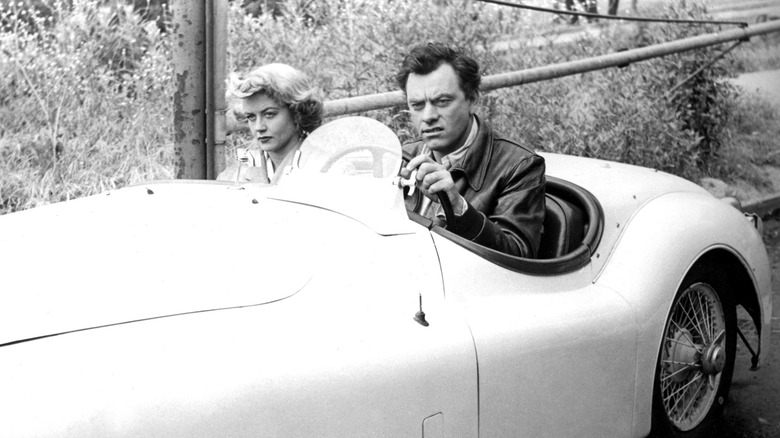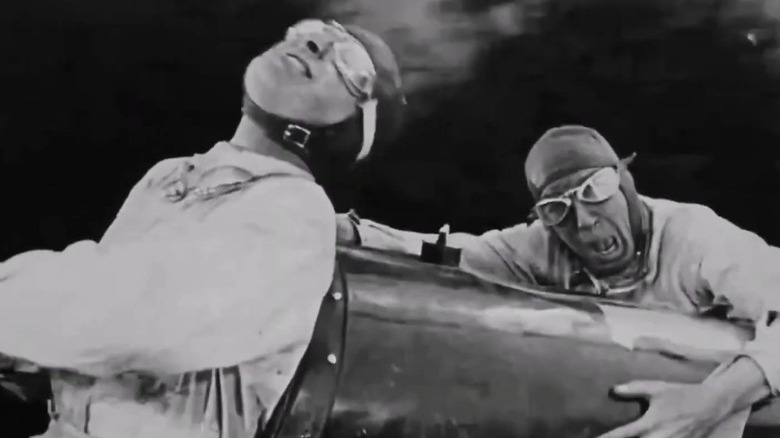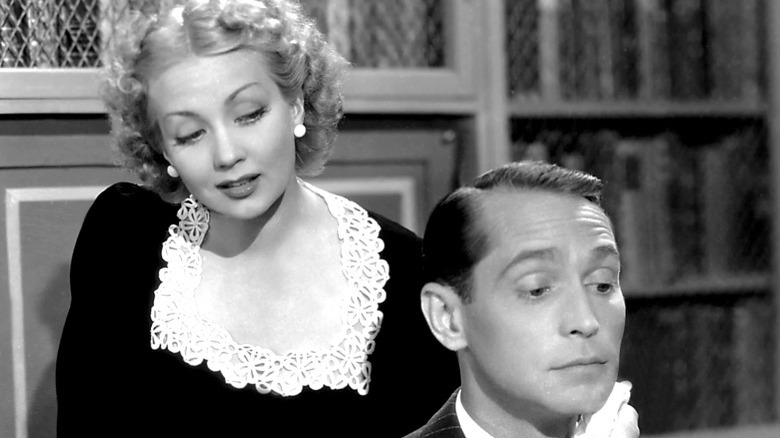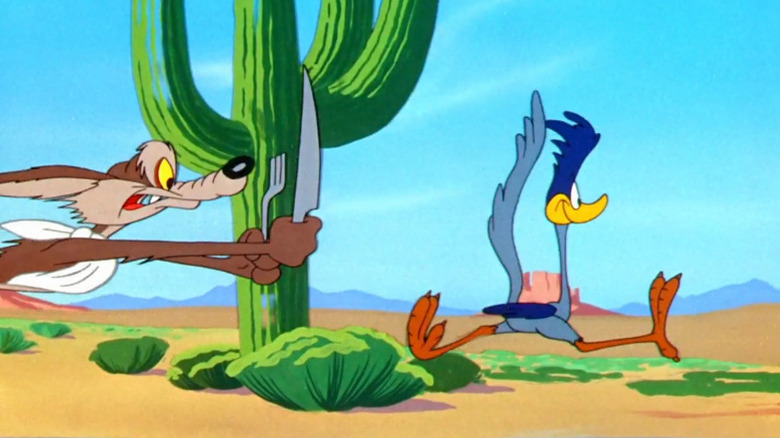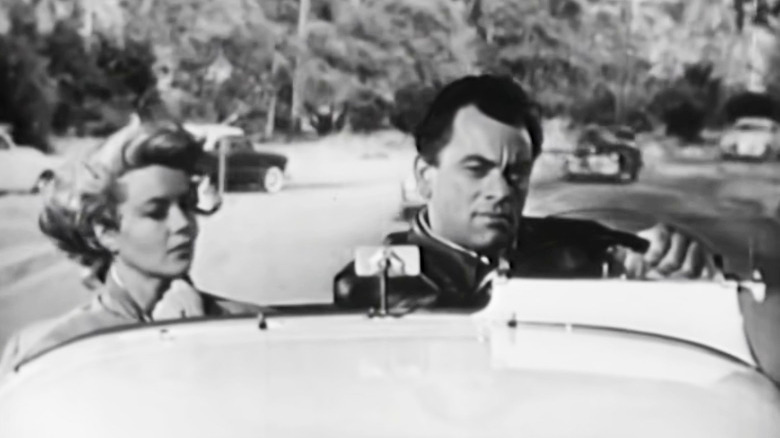The Vin Diesel-Led Dynasty Wasn't The First Fast And Furious In Hollywood
It's been 22 years since Rob Cohen directed a shameless knockoff of Kathryn Bigelow's "Point Break," starring Paul Walker instead of Keanu Reeves, Vin Diesel instead of Patrick Swayze, and street racing instead of surfing and sky diving. And while at the time, the success of the film "The Fast and the Furious" seemed only vaguely remarkable, over the course of the last two decades it has ballooned into a multi-billion dollar franchise, full of epic car stunts, ludicrous storylines, and endless ruminations about the meaning of "family."
Yes, "Fast and Furious" has become a household name, perhaps permanently associated with the blockbuster vehicular nonsense films of Vin Diesel and company. But it was not always this way. The common expression "fast and furious" has been used many times in Hollywood, for films about race car driving, funny murder mysteries, beloved Looney Tunes adventures, and low-budget crime thrillers.
Some of these other "Fast and Furious" movies are very good. Heck, some of them are so good that it's genuinely disappointing to know that in the eyes of many film fans, they're forever destined to be in the shadow of the modern cash cow action series. So let's take a look at them and find out which ones were fast, which ones were furious, and which ones are worth seeking out for yourselves.
Fast and Furious (1927)
There are quite a lot of short films from the silent era named after variations of the phrase "Fast and Furious," but not all of them are easy to track down. Fortunately, this wacky comedy starring Reginald Denny — who would go on to co-star in such classic talkies as Alfred Hitchcock's "Rebecca," which won the Academy Award for Best Picture, and the Adam West "Batman" movie — is easy to track down online and a lot of good-natured fun.
"Fast and Furious" stars Denny as Tom, a young man who gets into two car accidents within the course of five minutes, which gives him a terrible phobia of automobiles. In one of the accidents, he meets a grumpy tycoon named Smithfield (Claude Gillingwater) and his lovely daughter Ethel (Barbara Worth). After Tom recovers from his debilitating skull and spine injuries, he tracks Ethel down and tries to woo her but keeps getting into fights with her father, who hates his guts.
Through a series of elaborate shenanigans, Tom winds up impersonating a famous race car driver, so now Smithfield loves him, Ethel loves him, and all he's gotta do to is win a big race to save Smithfield's company and earn Ethel's hand in marriage. Except, again, Tom is still afraid of cars. And also, due to even more shenanigans — there are so many shenanigans, it's ridiculous — he has to win the race after being knocked out with ether and revived with pure alcohol. So he's extremely high and drunk.
"Fast and Furious" has a little bit of everything. Some of the car stunts are impressive for the era, the plot is the right kind of nonsense and the hero is a lovable sap who can't help getting into trouble. It's definitely fast, but only Smithfield seems particularly furious. And even he comes around eventually.
Fast and Furious (1940)
Blockbuster film franchises are nothing new, and in the 1930s one of the very biggest was MGM's "The Thin Man," a movie about a pair of witty, romantic, alcoholic super sleuths created by the great Dashiell Hammett. Over the course of six superior whodunnits, William Powell and Myrna Loy played Nick and Nora Charles as they bantered their way out of life-and-death situations.
And just like the blockbusters of today, the success of "The Thin Man" inspired knockoffs, including a trilogy of sexy comedy mysteries, also from MGM. The first, "Fast Company" (1938), stars Melvyn Douglas and Florence Rice as Joel and Garda Sloane, happily-married-but-down-on-their-luck rare book dealers investigating an insurance scam involving stolen first editions. One of the suspects ends up dead and it's up to them to solve the case and try not to get shot in the rear end too many times.
"Fast Company" is a wonderful film, on par with most of the better "Thin Man" movies, and its follow-up is almost as good. In "Fast and Loose" (1939), Joel and Garda are played by Robert Montgomery and Rosalind Russell, and the mystery involves a rare Shakespearean manuscript. The plot is clever, and while Montgomery doesn't have Douglas' joie de vivre, Russell — who would co-star in the classics "The Women" and "His Girl Friday" within the following year — was at the height of her comedic powers. She's brilliant here.
So it's a bit of a bummer that the third film, "Fast and Furious," is a step down. Franchot Tone and Ann Sothern ("My Mother the Car" herself) take over the lead roles in a mystery involving a beauty pageant, effectively abandoning the one unique element of the series: books. The plot isn't riveting, Tone isn't terribly convincing as a wry genius, and Sothern's performance is unexpectedly broad, but it's a harmless good time. The first two, however, are unsung classics.
Fast and Furry-ous (1949)
The early Looney Tunes shorts may not have been feature length, but they played in theaters, and one of the best and most significant is also called "Fast and Furious." Er, sorry, that's "Fast and Furry-ous." Because it's about animals, you see. It's got jokes and such.
The 1949 short "Fast and Furry-ous" wasn't just any old Looney Tune, it was the very first appearance of two of the funniest Looney Tunes ever: Wile E. Coyote and the Road Runner. Each short in their long-running series would find the Road Runner dashing through the desert at super speeds, while the hungry and industrious Wile E. Coyote uses every scheme and gadget he can come up with to capture his prey and stop starving to death.
So it was that "Fast and Furry-ous" introduced the now well-known formula: Wile E. Coyote sets up a series of traps for the Road Runner and the Road Runner finds humorously unexpected ways to survive. Some of these gags became legendary, like painting a realistic image of a tunnel onto the side of a mountain, only for the Road Runner to run right through it like it was real. And then of course, when Wile E. tries to run through it, he face-plants into solid rock. The laws of space and time never apply to the heroes of a Looney Tune, only to their enemies.
Everyone loves an underdog, and no dog was ever trampled under comedy's boots more forcefully than Wile E. Coyote. He tries to fulfill his function at the top of the food chain but gets stonewalled at every turn, sometimes literally. Future installments in the Coyote/Road Runner series would fine-tune and arguably perfect the formula, but it's all right here, practically from frame one. Very fast, and very furious.
The Fast and the Furious (1954)
The 1954 crime thriller "The Fast and the Furious" is another one for the history books. This low-budget vehicular thriller was one of the first films ever produced by the legendary Roger Corman, who would go on to direct hit movies and give many important directors their earliest breaks in the industry, like Martin Scorsese, Francis Ford Coppola, and James Cameron. It was also the first movie distributed by American Releasing Corporation, which would eventually become American International Pictures, which became a major industry player by focusing on genre films that appealed to teen demographics.
John Ireland, who co-directed "The Fast and the Furious," stars Frank Webster as a wanted fugitive who kidnaps Connie Adair (Dorothy Malone) at a roadside diner, so he can use her high-speed roadster as a getaway car and subsequently use a race she's driving in to cross the border into Mexico. Along the way, they evade capture in one high-speed chase after another, and eventually — and only somewhat convincingly — they also fall in love. A smart premise for a low-budget thriller but somehow, even at a trim 73 minutes, "The Fast and the Furious" is a little padded. Furious, sure, just not as fast as you might imagine.
"The Fast and the Furious" has the same name as the first film in Universal's billion-dollar franchise, and it's not a coincidence. Although the films don't have much in common besides crime and street racing, Universal made a deal with Roger Corman to adopt the title, reportedly in exchange for stock footage that Corman could use in his other projects. And you know what, that was a smart move by Universal, because one of the other titles they were considering was "Race Wars," and it's really hard to imagine a film called "Race Wars" spawning one of the biggest franchises of all time.
